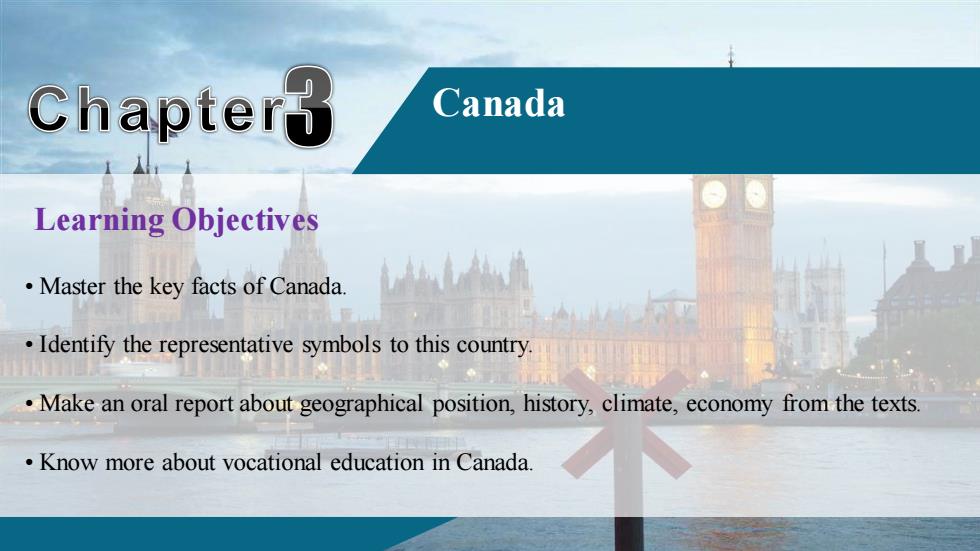
Chapterd Canada Learning Objectives Master the key facts of Canada. Identify the representative symbols to this country. Make an oral report about geographical position,history,climate,economy from the texts Know more about vocational education in Canada
Canada • Master the key facts of Canada. • Identify the representative symbols to this country. • Make an oral report about geographical position, history, climate, economy from the texts. • Know more about vocational education in Canada. Learning Objectives

Section A Exploring the World
Section A Exploring the World
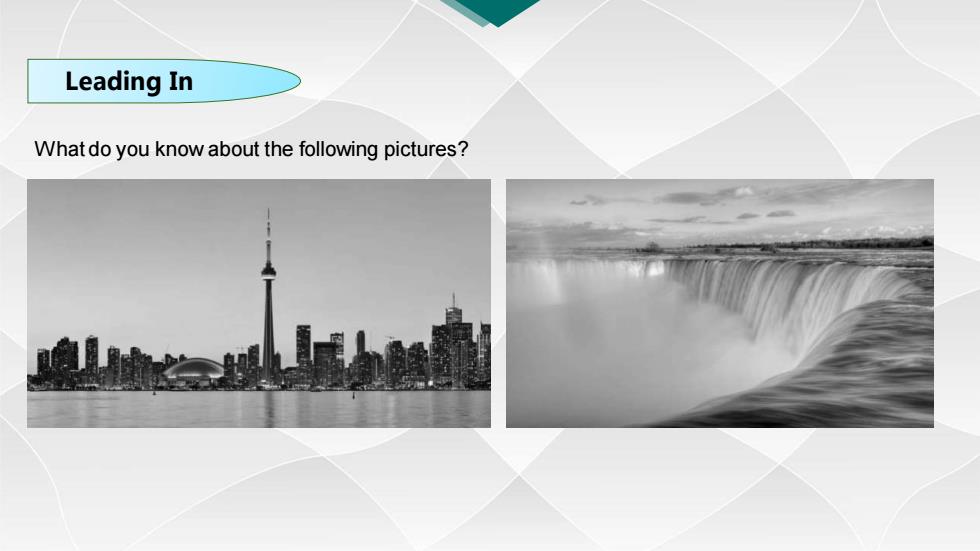
Leading In What do you know about the following pictures?
Leading In What do you know about the following pictures?
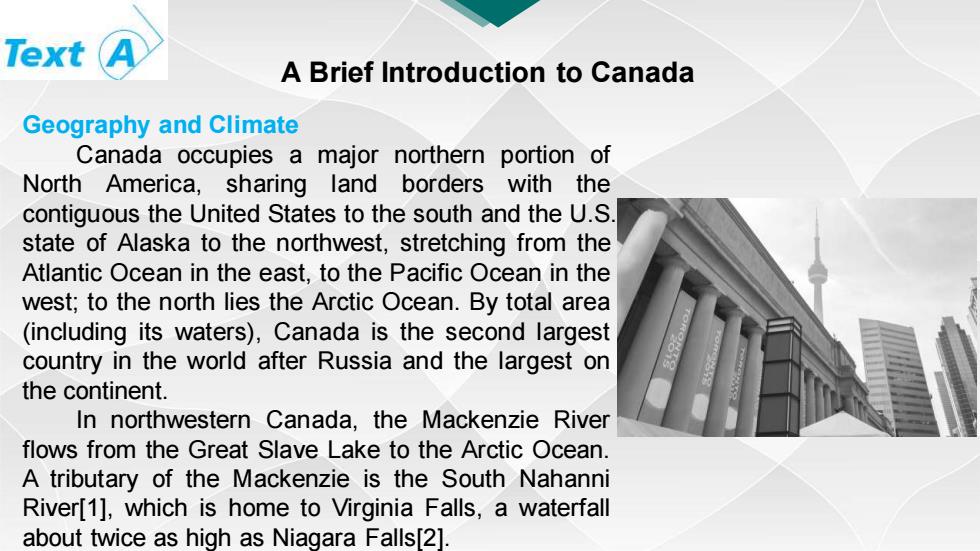
Text A Brief Introduction to Canada Geography and Climate Canada occupies a major northern portion of North America,s sharing land borders with the contiguous the United States to the south and the U.S. state of Alaska to the northwest,stretching from the Atlantic Ocean in the east,to the Pacific Ocean in the west;to the north lies the Arctic Ocean.By total area (including its waters),Canada is the second largest country in the world after Russia and the largest on the continent. In northwestern Canada,the Mackenzie River flows from the Great Slave Lake to the Arctic Ocean. A tributary of the Mackenzie is the South Nahanni River[1],which is home to Virginia Falls,a waterfall about twice as high as Niagara Falls[21
A Brief Introduction to Canada Geography and Climate Canada occupies a major northern portion of North America, sharing land borders with the contiguous the United States to the south and the U.S. state of Alaska to the northwest, stretching from the Atlantic Ocean in the east, to the Pacific Ocean in the west; to the north lies the Arctic Ocean. By total area (including its waters), Canada is the second largest country in the world after Russia and the largest on the continent. In northwestern Canada, the Mackenzie River flows from the Great Slave Lake to the Arctic Ocean. A tributary of the Mackenzie is the South Nahanni River[1], which is home to Virginia Falls, a waterfall about twice as high as Niagara Falls[2]

To the north of this region is the broad Canadian Shield,an area of rock scoured clean by the last ice age,thinly soiled,rich in minerals,and dotted with lakes and rivers.Canada has a lot of lakes and has much of the world's fresh water. Political System A federation comprising ten provinces and three territories,Canada is a parliamentary democracy and a constitutional monarchy,with Queen Elizabeth II as its head of state.It is a bilingual and multicultural country,with both English and French as official languages both at the federal level and in the province of New Brunswick
To the north of this region is the broad Canadian Shield, an area of rock scoured clean by the last ice age, thinly soiled, rich in minerals, and dotted with lakes and rivers. Canada has a lot of lakes and has much of the world’s fresh water. Political System A federation comprising ten provinces and three territories, Canada is a parliamentary democracy and a constitutional monarchy, with Queen Elizabeth Ⅱ as its head of state. It is a bilingual and multicultural country, with both English and French as official languages both at the federal level and in the province of New Brunswick
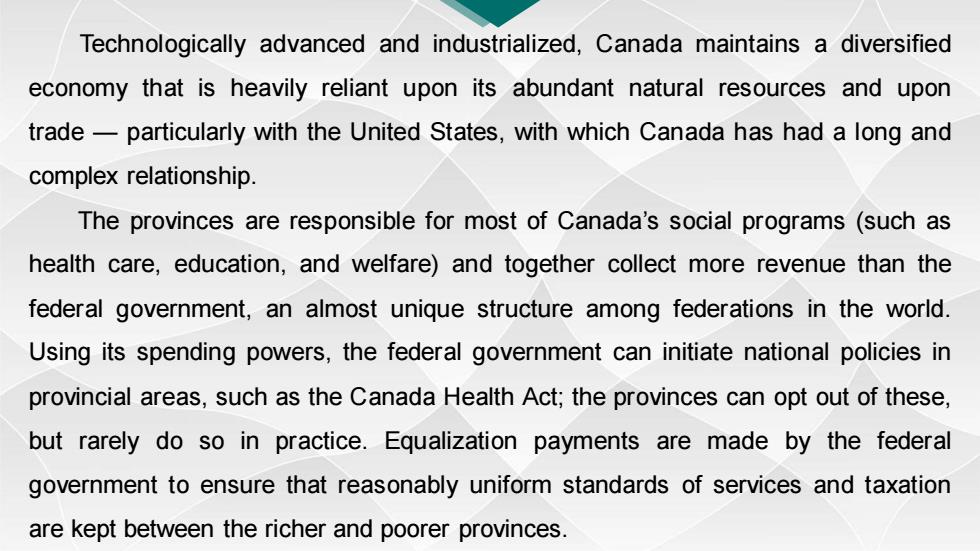
Technologically advanced and industrialized,Canada maintains a diversified economy that is heavily reliant upon its abundant natural resources and upon trade-particularly with the United States,with which Canada has had a long and complex relationship. The provinces are responsible for most of Canada's social programs (such as health care,education,and welfare)and together collect more revenue than the federal government,an almost unique structure among federations in the world. Using its spending powers,the federal government can initiate national policies in provincial areas,such as the Canada Health Act;the provinces can opt out of these, but rarely do so in practice.Equalization payments are made by the federal government to ensure that reasonably uniform standards of services and taxation are kept between the richer and poorer provinces
Technologically advanced and industrialized, Canada maintains a diversified economy that is heavily reliant upon its abundant natural resources and upon trade — particularly with the United States, with which Canada has had a long and complex relationship. The provinces are responsible for most of Canada’s social programs (such as health care, education, and welfare) and together collect more revenue than the federal government, an almost unique structure among federations in the world. Using its spending powers, the federal government can initiate national policies in provincial areas, such as the Canada Health Act; the provinces can opt out of these, but rarely do so in practice. Equalization payments are made by the federal government to ensure that reasonably uniform standards of services and taxation are kept between the richer and poorer provinces
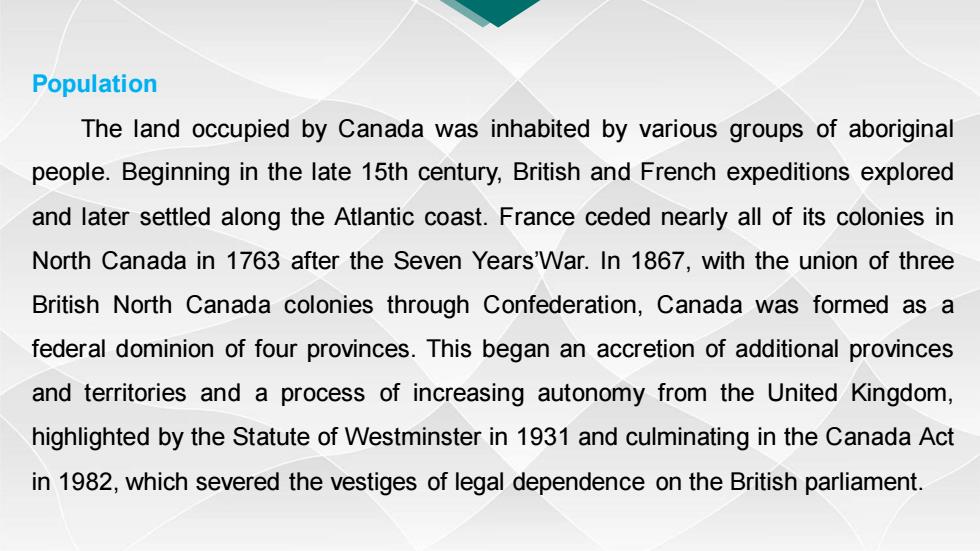
Population The land occupied by Canada was inhabited by various groups of aboriginal people.Beginning in the late 15th century,British and French expeditions explored and later settled along the Atlantic coast.France ceded nearly all of its colonies in North Canada in 1763 after the Seven Years'War.In 1867,with the union of three British North Canada colonies through Confederation,Canada was formed as a federal dominion of four provinces.This began an accretion of additional provinces and territories and a process of increasing autonomy from the United Kingdom, highlighted by the Statute of Westminster in 1931 and culminating in the Canada Act in 1982,which severed the vestiges of legal dependence on the British parliament
Population The land occupied by Canada was inhabited by various groups of aboriginal people. Beginning in the late 15th century, British and French expeditions explored and later settled along the Atlantic coast. France ceded nearly all of its colonies in North Canada in 1763 after the Seven Years’War. In 1867, with the union of three British North Canada colonies through Confederation, Canada was formed as a federal dominion of four provinces. This began an accretion of additional provinces and territories and a process of increasing autonomy from the United Kingdom, highlighted by the Statute of Westminster in 1931 and culminating in the Canada Act in 1982, which severed the vestiges of legal dependence on the British parliament

Canada's National Sports Canada's official national sports are hockey in winter and lacrosse in summer. Hockey is a national pastime and the most popular spectator sport in the country.It is also the most popular sport Canadians play.Canada's six largest metropolitan areas Toronto[3],Montreal,Vancouver,Ottawa,Calgary,and Edmonton have franchises in the National Hockey League (NHL),and there are more Canadian players in the league than from all the other countries combined.After hockey,other popular spectator sports include curling and football;the latter is played professionally in the Canadian Football League.Golf,baseball,skiing,soccer,volleyball,and basketball are widely played at youth and amateur levels,but professional leagues and franchises are not as widespread
Canada’s National Sports Canada’s official national sports are hockey in winter and lacrosse in summer. Hockey is a national pastime and the most popular spectator sport in the country. It is also the most popular sport Canadians play. Canada’s six largest metropolitan areas Toronto[3], Montreal, Vancouver, Ottawa, Calgary, and Edmonton have franchises in the National Hockey League (NHL), and there are more Canadian players in the league than from all the other countries combined. After hockey, other popular spectator sports include curling and football; the latter is played professionally in the Canadian Football League. Golf, baseball, skiing, soccer, volleyball, and basketball are widely played at youth and amateur levels, but professional leagues and franchises are not as widespread
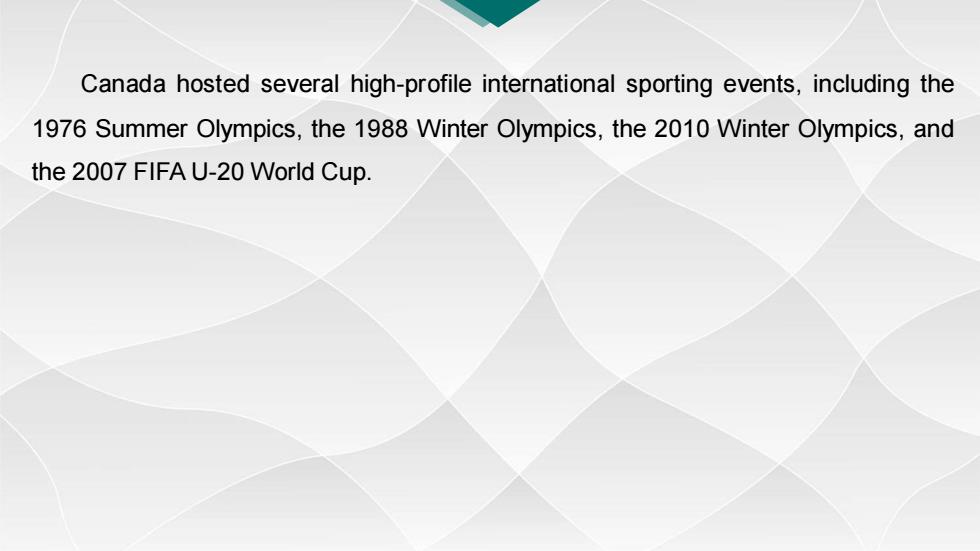
Canada hosted several high-profile international sporting events,including the 1976 Summer Olympics,the 1988 Winter Olympics,the 2010 Winter Olympics,and the 2007 FIFA U-20 World Cup
Canada hosted several high-profile international sporting events, including the 1976 Summer Olympics, the 1988 Winter Olympics, the 2010 Winter Olympics, and the 2007 FIFA U-20 World Cup
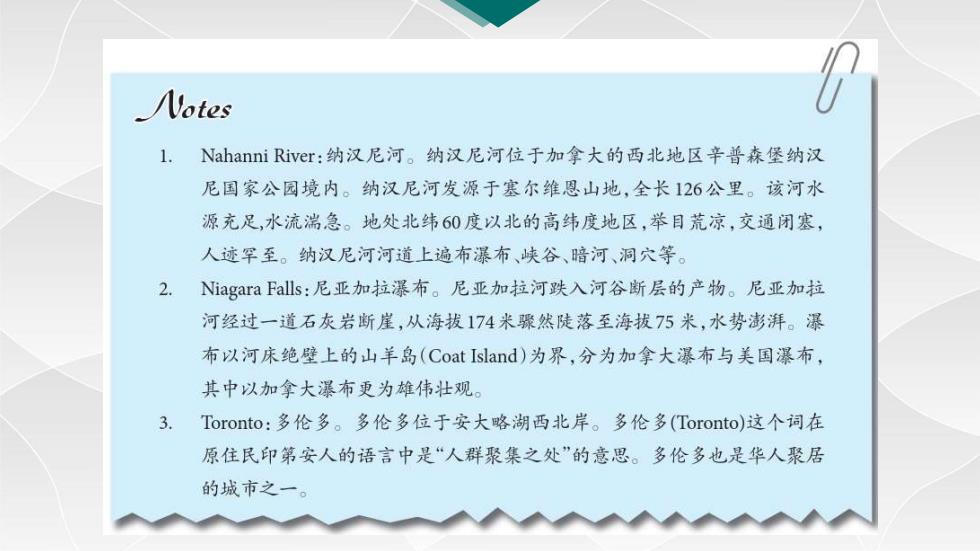
Notes 1. Nahanni River::纳汉尼河。纳汉尼河位于加拿大的西北地区辛普森堡纳汉 尼国家公园境内。纳汉尼河发源于塞尔维恩山地,全长126公里。该河水 源充足,水流湍急。地处北纬60度以北的高纬度地区,举目荒凉,交通闭塞, 人迹罕至。纳汉尼河河道上遍布瀑布、峡谷、暗河、洞穴等。 2. Niagara Falls:尼亚加拉瀑布。尼亚加拉河跌入河谷断层的产物。尼亚加拉 河经过一道石灰岩断崖,从海拔174米骤然陡落至海拔75米,水势澎湃。瀑 布以河床绝壁上的山羊岛(Coat Island)为界,分为加拿大瀑布与美国瀑布, 其中以加拿大瀑布更为雄伟壮观。 3. Toronto:多伦多。多伦多位于安大略湖西北岸。多伦多(Toronto)这个词在 原住民印第安人的语言中是“人群聚集之处”的意思。多伦多也是华人聚居 的城市之一